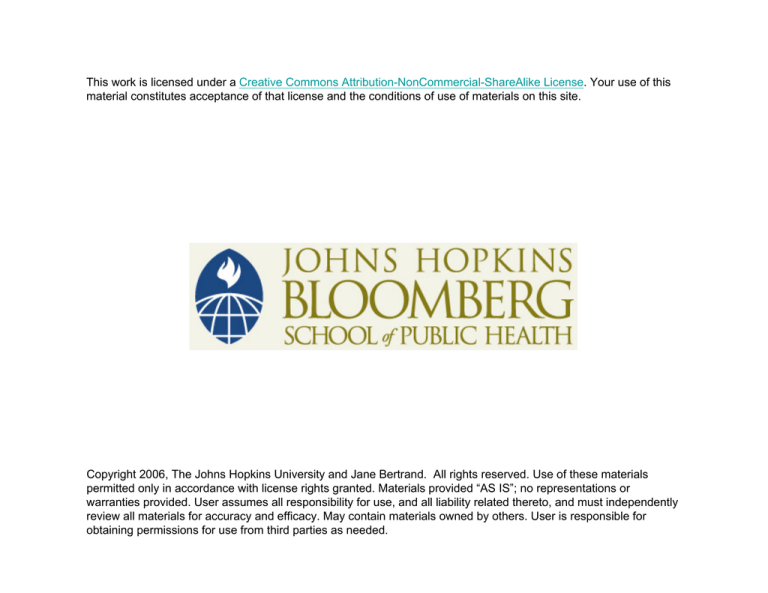
This work is licensed under a Creative Commons Attribution-NonCommercial-ShareAlike License. Your use of this
material constitutes acceptance of that license and the conditions of use of materials on this site.
Copyright 2006, The Johns Hopkins University and Jane Bertrand. All rights reserved. Use of these materials
permitted only in accordance with license rights granted. Materials provided “AS IS”; no representations or
warranties provided. User assumes all responsibility for use, and all liability related thereto, and must independently
review all materials for accuracy and efficacy. May contain materials owned by others. User is responsible for
Fundamentals
of Program
Evaluation
obtaining
permissions
for use from
third parties as needed.
Fundamentals of Program Evaluation
Course 380.611
Monitoring Outputs and Outcomes
And Introduction to Study Design
Fundamentals of Program Evaluation
Topics to cover
RHIS as a tool to monitor outputs and
outcomes
Use of surveys to monitor outcomes
Break
Threats to validity
Intro to “impact”
Fundamentals of Program Evaluation
Purpose of MIS at local level
Management to track:
Inputs (finances, personnel)
Process (description of activities)
Outputs
# activities conducted
Measures of access (optional)
Results (# products distributed, service
utilization)
Fundamentals of Program Evaluation
Inputs: Finance, Personnel
Essential data for management
Less important for M&E
Covered in management course, not
Evaluation Course
Dissenting comment by Duff Gillespie
Fundamentals of Program Evaluation
Process
Records of training courses
Records on activities implemented
(type, purpose, # participants)
Evaluation of quality of services
Note: database for determining:
Was project implemented as planned
How well was it implemented
Fundamentals of Program Evaluation
Outputs – Two main types
Number of activities conducted
# persons trained
# pamphlets, posters produced/distributed
Results:
# products distributed
Volume of service utilization
Profile of clients
Note: all data are program - level
Fundamentals of Program Evaluation
Typical “results” from tracking
outputs (service utilization)
Fundamentals of Program Evaluation
Steps in establishing an MIS
for service statistics
Determine indicators to track
Design forms to collect the data
Assign responsibility for data collection
Establish a system of remitting the data
back to the central offices
Train staff in use of the forms
Ensure timely submission of data
Fundamentals of Program Evaluation
Fundamentals of Program Evaluation
Monitoring outcomes
Program-based measurement
Available through RHIS
Ex: % of TB patients enrolled who
complete treatment
Population-based measurement
Not available through RHIS
Ex: % contraceptive use over time
Fundamentals of Program Evaluation
Utility of data from monitoring
To track levels in a given service over
time
To compare regions/sites on
key indicators
To compare program performance to
specified standards
Fundamentals of Program Evaluation
Example of monitoring
outputs: # condoms sold
From Gardner, R., Blackburn, R.D., and Upadhyay, U.D. Closing the Condom Gap. Population Reports, Series H, No.
Fundamentals
Program
Evaluation
9. Baltimore,
Johnsof
Hopkins
University
School of Public Health, Population Information Program, April 1999.
n.
-M
A ar
pr ch
il 9
Ju -J u n 8
ly e
O -S e 9 8
ct p.
Ja .- D e 9 8
n.
-M c. 9
A a rc 8
pr h
il 9
Ju -J u n 9
ly e
- 9
O S ep 9
c
.
J a t.- D 9 9
n.
-M e c.9
A ar 9
pr ch
il 0
Ju -J u n 0
ly e
O -S e 0 0
ct p.
Ja .- D e 0 0
n.
-M c. 0
A ar 0
pr ch
il 0
Ju -J u n 1
ly e
O -S e 0 1
ct p.
Ja .- D e 0 1
n.
-M c. 0
A ar 1
pr ch
il 0
Ju -J u n 2
ly e
O -S e 0 2
c t. p .
-D 02
ec
.0
2
Ja
Number of condoms distributed,
Ghana 1998-2002
Launch of Stop AIDS
Love Life
Launch of Life Choices
8000000
7000000
6000000
5000000
4000000
3000000
2000000
1000000
0
of Program
Evaluation
Source:Fundamentals
Ghana’s Stop
AIDS Love
Life Program. Phase 1: Evaluation Report. February 2000 to June 2001
Use of male methods: comparisons
by country and across time
Fundamentals of Program Evaluation
Source: Drennan, M. Reproductive Health: New Perspectives on Men's Participation. Population Reports, Series
J, No. 46. Baltimore, Johns Hopkins School of Public Health, Population Information Program, October 1998.
Advantages of a health MIS
Routine:
Local:
Doesn’t require a special study
Existing staff collect the info
Provides info relevant to local program
Timely:
Data are available on a monthly or
quarterly basis
Fundamentals of Program Evaluation
Shortcomings of Health MIS
Data are often of poor quality
Data collection detracts from clinical
service delivery (I.e., takes time)
Data are often sent to the central level
without being used at local level
Staff at the local level may not feel
comfortable “analyzing” the data
Fundamentals of Program Evaluation
…As a result...
Service statistics often provide
unreliable data on health interventions
Inflated results
Staff disinterested in process
One-way flow of info (no local benefit)
Result: widespread use of DHS-type
surveys instead of routine service
statistics
Fundamentals of Program Evaluation
So what is “program
monitoring?”
Can include tracking activities:
# training events, # materials produced
Also tracks program-level results:
Levels of service delivery
(behavior-related) products distributed
May track outcomes:
Percent of target population performing
behavior
Fundamentals of Program Evaluation
Fundamentals of Program Evaluation
Measuring “reach” (using
survey data)
Example from Stop AIDS Love Life
Ghana
Social Marketing
Foundation
(GSMF)|USAID|Johns Hopkins University
Fundamentals
of Program
Evaluation
Exposure to the Stop AIDS Love Life
campaign components, Males, 2001
Spontaneous
Prompted
Overall
TV
Music video
Radio
Newspaper
Poster
Leaflet
Car sticker
Tee-shirt/cap
Mobile van
Community event
Community rally
0
Source: 2001 GRHCSS
N=1270
Fundamentals of Program Evaluation
20
40
60
80
% of male respondents exposed
100
Monitoring outcomes:
Initial outcomes
–
Intermediate outcomes
–
Useful if topic is new, difficult (e.g., FGM)
Focus of much evaluation
Long-term outcomes
–
Important but they change slowly; other
factors contribute
Fundamentals of Program Evaluation
Initial outcomes
Knowledge
Attitudes
Self-efficacy
Question: why do we care?
(Example: knowledge of HIV/AIDS in the
U.S. in mid-1980s)
Fundamentals of Program Evaluation
Intermediate outcomes
Health behavior, practice: examples
% employees who exercise 3
times/week
% 15-19 years olds who don’t smoke
% of infants fully immunized at 12
months
% pregnant women who deliver with
skilled birth attendant
Fundamentals of Program Evaluation
Long-term outcomes
Fertility
–
Morbidity
–
–
HIV prevalence
% diarrheal disease (past month)
Mortality
–
Total fertility rate
Infant mortality, maternal mortality
Quality of life
Fundamentals of Program Evaluation
Source of data (if populationbased)
Representative survey of the general
population (or relevant subsection)
Census (e.g., fertility, mortality rates)
National or regional surveys (e.g.,
DHS)
Fundamentals of Program Evaluation
Differentiating Outputs versus
Outcomes
Output: measured at program level:
Activities conducted:
Service utilization:
# brochures printed
# client visits, # condoms sold, # HIV tests
performed
Outcomes: program or population level:
% of TB patients successfully treated
% of youth using condom at last sex
Fundamentals of Program Evaluation
OUTPUTS OR
OUTCOMES?
Fundamentals of Program Evaluation
Source: Gardner, R., Blackburn, R.D., and Upadhyay, U.D. Closing the Condom Gap. Population Reports, Series H, No.
9. Baltimore, Johns Hopkins University School of Public Health, Population Information Program, April 1999.
Value of monitoring outcomes
Demonstrates trends at
national/regional level
Useful for policy makers and public
health practitioners
Allows for comparisons: cross-national
and over time
Fundamentals of Program Evaluation
Example: tracking contraceptive
use over time: 4 countries
U s e o f A n y C o n t r a c e p t iv e M e t h o d
100
90
80
Cameroon
70
Kenya
% use M W R A
60
50
Senegal
40
30
Eg y p t
20
10
0
1970s
1980s
1990s
2000s
d e cad e
of Program
Evaluation
Source:Fundamentals
Ghana’s Stop
AIDS Love
Life Program. Phase 1: Evaluation Report. February 2000 to June 2001
Limitations of monitoring
outcomes
Program-based:
What happened to those outside program?
Population-based:
Does not measure causation
Is often misunderstood as demonstrating
cause and effect
Survey data collection is costly, infrequent
Fundamentals of Program Evaluation
Question
Can we use qualitative methods to
measure outcomes?
Fundamentals of Program Evaluation
Question
When is monitoring outcomes
“enough”? (or “appropriate”)
Fundamentals of Program Evaluation
Moving from monitoring
change to measuring impact
Fundamentals of Program Evaluation
Donors, program administrator,
providers, evaluators:
Want to know:
● Did this program make a difference?
● Did it have an impact?
● Did the program cause the
desired/observed change?
Fundamentals of Program Evaluation
To answer this question, need
to have:
Appropriate study design, and/or
Appropriate statistical analysis
(based on advanced multivariate
analysis)
Fundamentals of Program Evaluation
Review of two key
measurement concepts
Reliability: The measure
repeatedly gives the same results
Validity: We are measuring what
we think we are measuring
Fundamentals of Program Evaluation
Measurement of validity
Considers systematic error: a true effect
may be biased positively or negatively
How well measures represent underlying
concepts
Objective behavior measures more likely
valid
More difficult to assess than reliability
Fundamentals of Program Evaluation
Study design needs to control
for threats to validity
History
Maturation
Testing
Instrumentation
Regression
Selection
Attrition
Fundamentals of Program Evaluation
Threats to internal validity
History: discrete events external to
units
Maturation: events occurring within
subjects over time
Testing: pretest influences results
Fundamentals of Program Evaluation
Threats to internal validity,
continued
Instrumentation: changes in instrument
or raters influences results
Regression (to the mean): units chosen
on extreme scores will naturally regress
Selection: compositional differences in
treatment and comparison groups
Fundamentals of Program Evaluation
Threats to internal validity,
continued
Attrition: differential dropout of units
between treatment, control groups
Selection-maturation interaction:
selection differences cause different
maturation effects
Olympic athletes versus couch potatoes
Fundamentals of Program Evaluation
Threats to internal validity,
continued
Selection-history interaction:
selection differences cause different
exposures to historical events
Ex: effect of Magic Johnson’s HIV
announcement on blacks and whites
Fundamentals of Program Evaluation
Which study designs (next class)
control to threats to validity?
Experimental (randomized control trials)
Quasi-experimental
Controls some threats to validity
Non experimental
“gold standard” for assessing impact
Controls threat to validity
Do not control threats to validity
Observational with statistical controls:
Controls some threats to validity
Fundamentals of Program Evaluation







